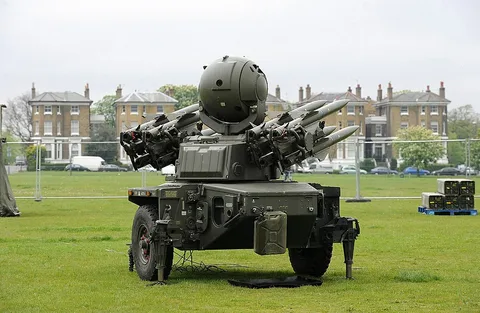
In 2024, the global anti-aircraft warfare industry is expected to reach a value of USD 22.7 billion, with projections indicating it could grow to USD 46.1 billion by 2034. This represents an average annual growth rate of 7.4% over the period from 2024 to 2034. The market’s expansion is driven by the continuous enhancement of air defense systems, incorporating advanced technologies such as state-of-the-art radar, missile defense systems, and network-centric capabilities to counter evolving aerial threats.
The Anti-Aircraft Warfare Industry is set to witness significant growth between 2024 and 2032, fueled by rising global defense spending, geopolitical tensions, and advancements in military technology. Anti-aircraft systems, designed to detect, track, and neutralize aerial threats, play a pivotal role in modern defense strategies, safeguarding airspace and critical assets.
The increasing adoption of advanced radar systems, precision-guided missiles, and integrated air defense systems is transforming the anti-aircraft warfare landscape. Moreover, the rise of unmanned aerial vehicles (UAVs) and drone technologies has necessitated the development of counter-drone systems and next-generation weaponry.
Key market players are leveraging innovations in artificial intelligence (AI), sensor technologies, and network-centric warfare to enhance operational efficiency and response capabilities. Government investments in bolstering air defense systems and collaborations with private defense contractors are also driving market growth.
Key Drivers of the Anti-Aircraft Warfare Industry
- Rising Global Defense Budgets: Increased military spending by nations to address escalating security threats boosts market demand.
- Advancements in Missile and Radar Technologies: Development of precision-guided missiles, AI-powered radars, and electronic warfare systems enhances anti-aircraft capabilities.
- Emergence of Drone and UAV Threats: Growing use of drones in warfare accelerates the need for counter-drone technologies and air defense systems.
- Geopolitical Tensions: Regional conflicts and territorial disputes push nations to strengthen their air defense infrastructures.
- Shift Toward Network-Centric Warfare: Integration of real-time data sharing, AI, and advanced sensors improves decision-making and response times in air defense.
Key Takeaways from the Anti-Aircraft Warfare Industry
- The global Anti-Aircraft Warfare Market is projected to grow steadily, driven by innovations in missile systems, radars, and counter-drone technologies.
- North America dominates the market due to significant investments in air defense modernization, while Asia-Pacific is emerging as a fast-growing region amid increasing regional security concerns.
- Key technologies, including AI-driven systems, advanced surveillance radars, and hypersonic missiles, are shaping the future of anti-aircraft warfare.
- Leading players like Raytheon Technologies, Lockheed Martin, Thales Group, Northrop Grumman, and BAE Systems are investing in R&D to enhance their product portfolios.
- The rise of autonomous aerial threats has spurred the development of directed energy weapons, electronic warfare systems, and integrated air defense networks.
Exhaustive Market Report: A Complete Study
Key Companies in the Anti-aircraft Warfare Industry
- Lockheed Martin Corporation
- Raytheon Technologies
- Northrop Grumman Corporation
- BAE Systems plc
- Thales Group
- MBDA
- Israel Aerospace Industries Ltd.
- Kongsberg Gruppen ASA
- Leonardo S.P.A.
- Rafael Advanced Defense Systems Ltd.
- Rheinmetall AG
Key Segmentations
By Capability:
- Support
- Protection
- Attack
By System:
- Weapon Systems
- o Anti Aircraft Gun
- o Anti Aircraft Missile
- Others
- Radar System
- Electronic Warfare System
- Command and Control System
By Platform:
- Airborne
- Combat Aircraft
- Military Helicopters
- Unmanned Aerial Vehicles (UAVs)
- Land
- Military Vehicular
- Dismounted Soldier
- Fixed Stations
- Naval
- Naval Ships
- Unmanned Surface Vehicles (USVS)
By Range:
- Short Range (<20 Km)
- Medium Range (20 to 100 Km)
- Long Range (>100 Km)
By Region:
- North America
- Latin America
- Europe
- East Asia
- South Asia
- Oceania
- The Middle East and Africa
About Future Market Insights (FMI)
Future Market Insights, Inc. (ESOMAR certified, recipient of the Stevie Award, and a member of the Greater New York Chamber of Commerce) offers profound insights into the driving factors that are boosting demand in the market. FMI stands as the leading global provider of market intelligence, advisory services, consulting, and events for the Packaging, Food and Beverage, Consumer Technology, Healthcare, Industrial, and Chemicals markets. With a vast team of 400 analysts worldwide, FMI provides global, regional, and local expertise on diverse domains and industry trends across more than 110 countries.
Contact Us:
Future Market Insights Inc.
Christiana Corporate, 200 Continental Drive,
Suite 401, Newark, Delaware – 19713, USA
T: +1-347-918-3531
For Sales Enquiries: sales@futuremarketinsights.com
Website: https://www.futuremarketinsights.com
LinkedIn| Twitter| Blogs | YouTube





